The default WordPress login page works fine, but it won’t fully represent your brand. To create a more engaging experience, it’s important to showcase your brand and business on this page.
A custom login page design is especially impactful for membership sites or online stores, where users frequently interact with the login page.
That’s why at WPBeginner, we’ve set up a custom login page for our free WordPress video training website. It helped us showcase our brand more prominently while improving the user experience.
In this guide, we will show you how to create a custom WordPress login page. We will explore multiple methods so you can choose the one that best suits your business needs.
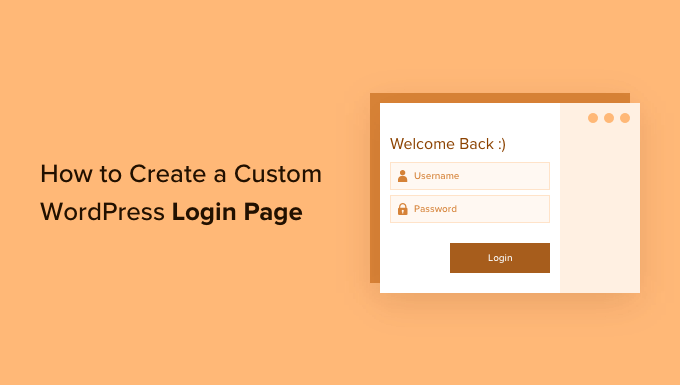
Here is what you will learn from this guide:
- Why Create a Custom WordPress Login Page?
- WordPress Login Page Design Examples
- Creating a WordPress Login Page Using Theme My Login (Free)
- Creating a Custom WordPress Login Page Using WPForms
- Creating a Custom WordPress Login Page Using SeedProd (Recommended)
- Change the WordPress Login Logo and URL
- Disabling the WordPress Login Page Language Switcher
Why Create a Custom WordPress Login Page?
Your WordPress website comes with a powerful user management system. It allows users to create accounts in eCommerce stores, membership websites, and blogs.
By default, the login page shows the WordPress branding and logo. This is fine if you are the only person with admin access or have very few users.
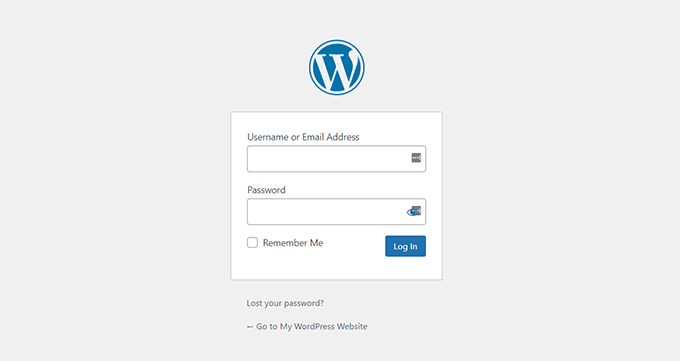
However, if your website allows users to register and log in, then a custom login page offers a better user experience.
Some users may be suspicious if your WordPress login screen looks nothing like your website. They will likely feel more at home if you use your business logo and design.
Lastly, the default login screen contains nothing but the login form. By creating a custom login page, you can use the space to promote other pages or special offers.
That’s why we use a custom login page for all our websites where users need to interact with a login form.
For instance, here is the custom login page we use for the WPBeginner training videos website.
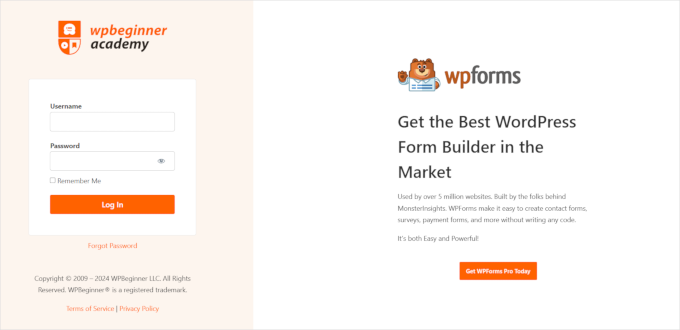
That being said, let’s look at some more examples of custom WordPress login page designs.
WordPress Login Page Design Examples
Website owners can customize the WordPress login page using different styles and techniques.
Some create a custom login page that uses their website’s theme and colors. Others modify the default login page by adding a custom background, colors, and logo.
Here are a few examples of what’s possible.
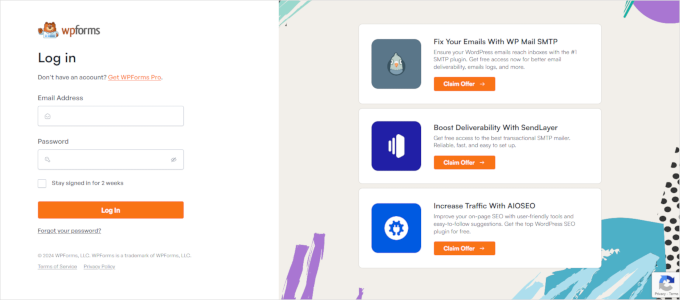
WPForms is the best WordPress contact form plugin on the market. Their plugin also includes an add-on to create beautiful WordPress login and registration forms, which we will show you later in this article.
Their custom login page uses a two-column layout. The left column contains the login form, and the right column highlights promotions and other calls to action.
Their login page shown above lets their users know about new features. It uses custom branding, background illustration, and brand colors to create a unique login experience.
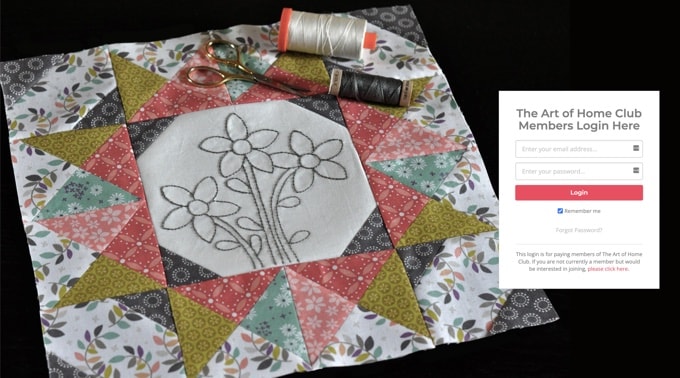
Jacquelynne Steeves is an arts and crafts website where the author publishes content about decorating homes, making quilts, patterns, embroidery, and more.
Their login page uses a custom background image that matches the theme of their website, and the login form is on the right.
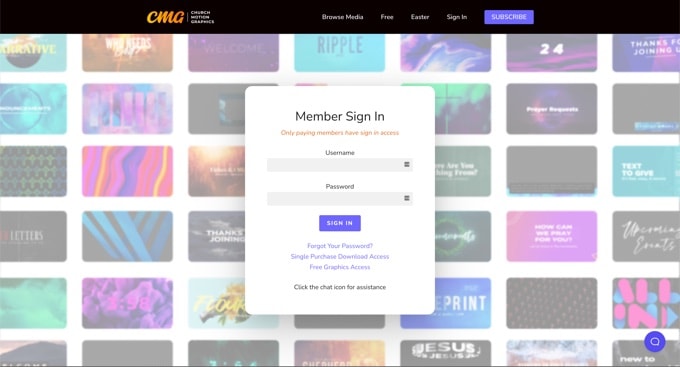
The login page of this motion graphics design company has a colorful background that reflects its business.
It uses the same site header, footer, and navigation menus on the login screen. The login form itself is pretty simple, with a light background.
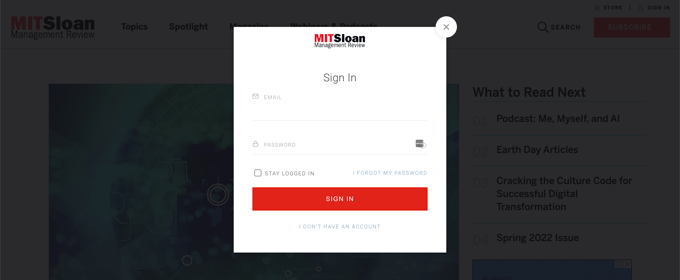
MITSloan Management Review uses a popup modal to display a login and registration form.
The advantage of a popup is that users can log in without leaving the page. It saves them from a new page load and offers a faster user experience.
Now, are you ready to learn how to create a custom login page in WordPress?
Creating a WordPress Login Page Using Theme My Login (Free)
Theme My Login is a free plugin that changes your login page to match your WordPress theme. It’s not very customizable, but it will replace the default WordPress-branded login page and make it look more professional.
The first thing you need to do is install and activate the Theme My Login plugin. For more details, see our step-by-step guide on how to install a WordPress plugin.
Upon activation, Theme My Login automatically creates URLs for your custom login, logout, registration, forgot password, and reset password actions.
You can customize these WordPress login URLs by visiting the Theme My Login » General page. Scroll down to the ‘Slugs’ section to modify the URLs used by the plugin for login actions.
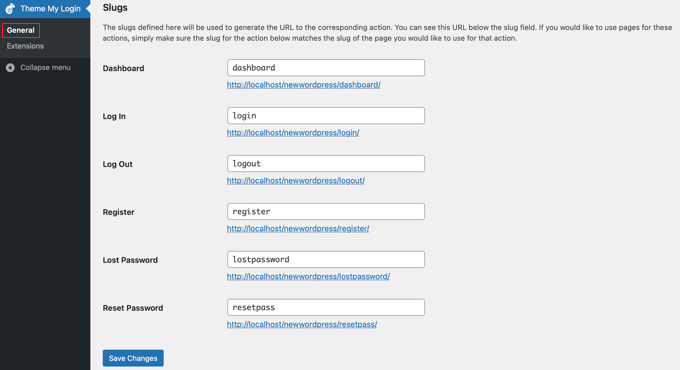
Theme My Login also allows you to use shortcodes to create custom login and registration pages. You can simply create a page for each action and then add the page slug here so that the plugin can find and redirect users properly.
Let’s start with the login page.
Head over to Page » Add New to create a new WordPress page. Next, you need to give your page a title and then enter the following shortcode [theme-my-login] to the page.
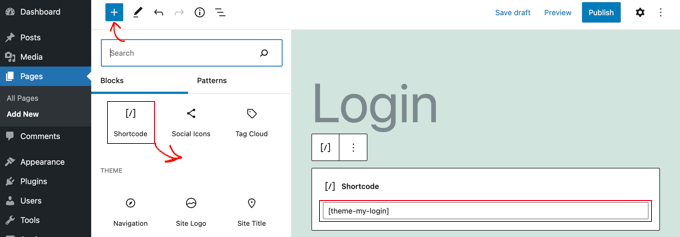
You can now publish your page and preview it to see your custom login page in action.
This is how it looks on our test WordPress website.
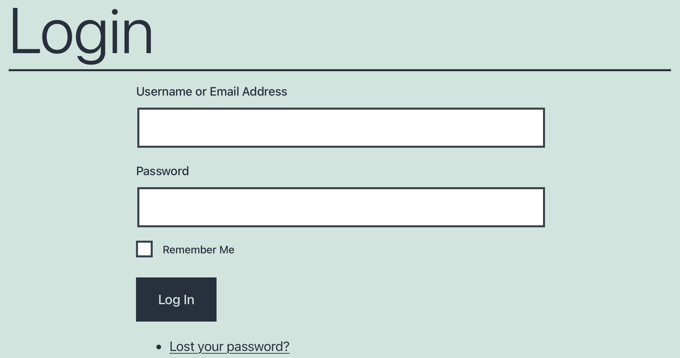
Repeat the process to create other pages by using the following shortcode:
[theme-my-login action="register"] For the registration form
[theme-my-login action="lostpassword"]For the lost password page
[theme-my-login action="resetpass"] For the reset password page
Creating a Custom WordPress Login Page Using WPForms
WPForms is the best WordPress form builder plugin on the market. It allows you to easily create custom login and registration forms for your website.
WPForms is a premium WordPress plugin, and you will need at least their pro plan to access the User Registration add-on. WPBeginner users can get a 50% discount by using our WPForms coupon code: SAVE50
The first thing you need to do is install and activate the WPForms plugin. For more details, see our step-by-step guide on how to install a WordPress plugin.
Upon activation, you need to visit the WPForms » Settings page to enter your license key. You can find this information in your account on the WPForms website.
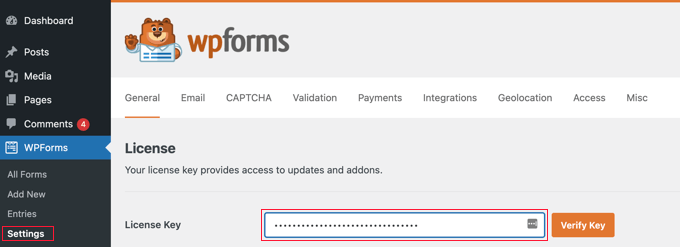
After entering the license key, you’ll be able to install add-ons.
Go ahead and visit the WPForms » Addons page and locate the User Registration Addon.
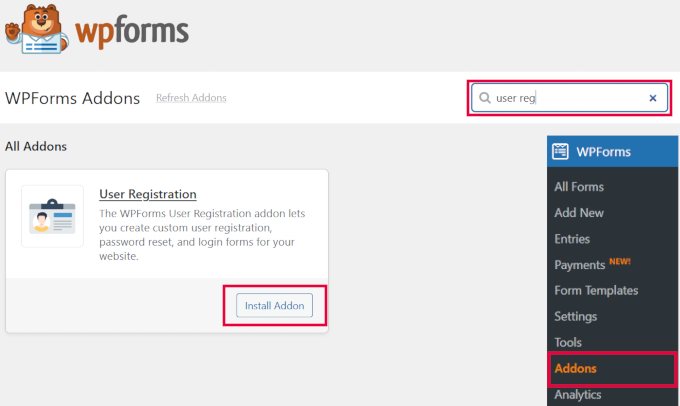
Next, click the ‘Install Addon’ button to download and activate the addon. You are now ready to create your custom login forms.
Head over to WPForms » Add New page. You’ll be asked to ‘Select a Template’ for your form. Search for the ‘User Login Form’ template and click the ‘Use Template’ button to continue.
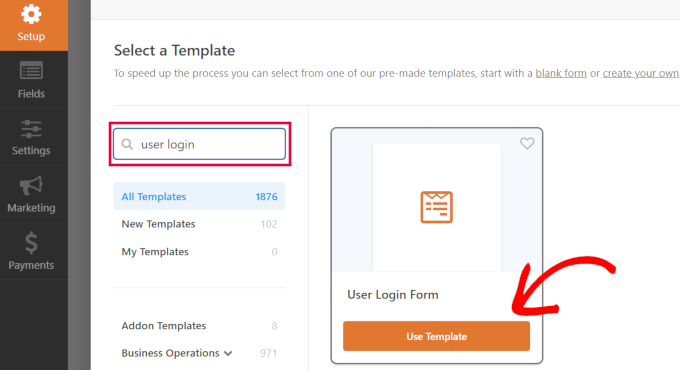
Expert Tip: WPForms also has an AI form builder that you can use. Simply type in a description of the type of form you want, and WPForms will create it for you!
WPForms will load the User Login Form with the required fields.
You can click on the fields to add your own description or text around them.
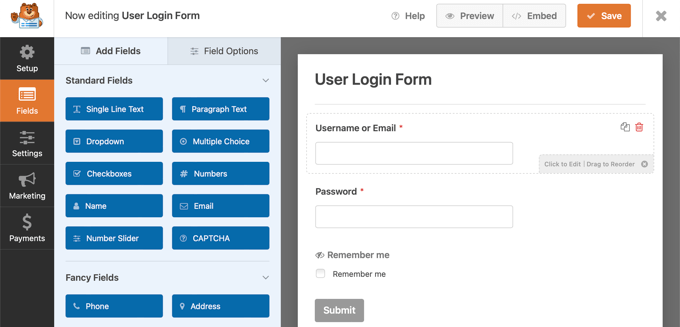
You can change other settings as well.
For example, the default button title is ‘Submit’. You can click the button and change the text to ‘Login’ instead.
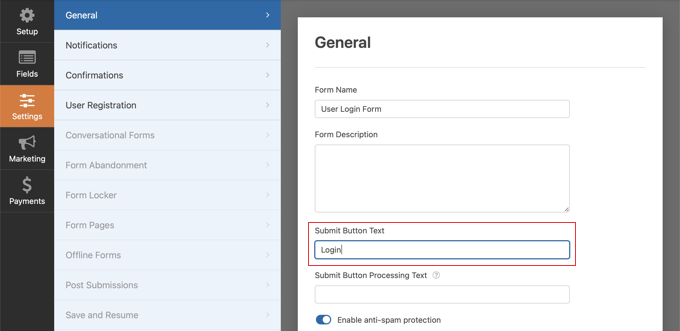
You can also decide what happens once a user is successfully logged in.
You’ll need to head over to the Settings » Confirmation tab and select an action. You can redirect the user to any other URL, redirect them to the homepage, or simply show them a message that they are now logged in.

Once you are satisfied with the form settings, click the ‘Save’ button at the top right corner of the screen to close the form builder.
Adding Your Custom Login Form to a WordPress Page
WPForms makes it super easy to add your custom login form on any WordPress post or page.
Simply edit the page where you want to add the login form or create a new one. Then, on the page edit screen, add the WPForms block to your content area.
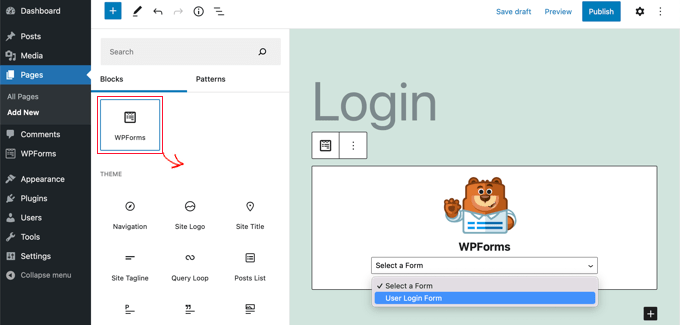
Next, select the login form you created earlier, and the WPForms block will automatically load it inside the content area.
You can now continue editing the login form page. Feel free to add more text or promotional blocks. Once you are finished, don’t forget to save and publish your changes.
You can now visit your website to see your login page in action.
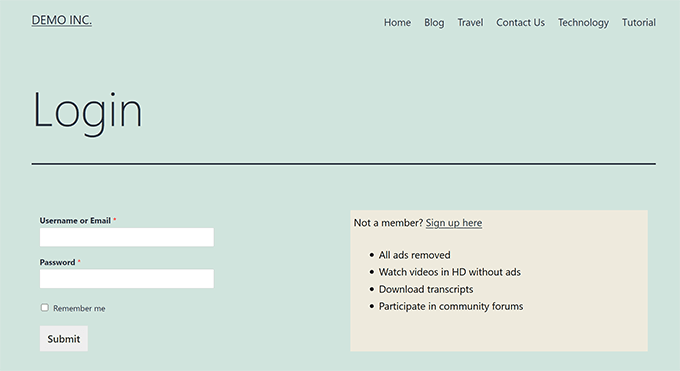
Creating a Custom WordPress Login Page Using SeedProd (Recommended)
By default, your custom WordPress login form page will use your theme’s page template and styles. It will have your theme’s navigation menus, header, footer, and sidebar widgets.
If you want to take over the entire page completely and design something from scratch, then you can use a WordPress page builder plugin.
SeedProd is the best landing page builder for WordPress. It’s beginner-friendly and offers a drag-and-drop builder to help you create any type of landing page, including a login page, coming soon page, maintenance mode page, and more.
For this article, we will be using the SeedProd Pro version because it includes a login page template and advanced page blocks for customization.
There is also a free version of SeedProd, but it doesn’t include the option to create a login page for your WordPress website.
First, you’ll need to install the SeedProd plugin on your website. For more details, you can follow our guide on how to install a WordPress plugin.
Once the plugin is active, you’ll be redirected to SeedProd in your WordPress admin area.
Here, you’ll need to enter your license key, which you can easily get from the SeedProd account. When you’ve entered the key, click the ‘Verify key’ button.

After that, you are ready to create your login page in SeedProd.
To start, head over to the SeedProd » Landing Pages and select the ‘Login Page’ option by clicking the ‘Set up a Login Page’ button.
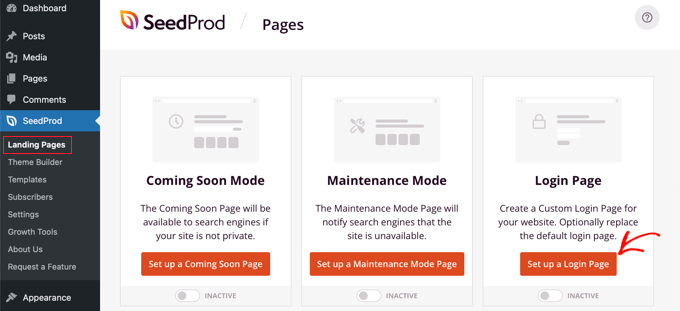
On the next screen, you can select a template for your login page. You can also create a page from scratch using the Blank Template.
However, we suggest using a template as it’s easier and faster to customize the login page.
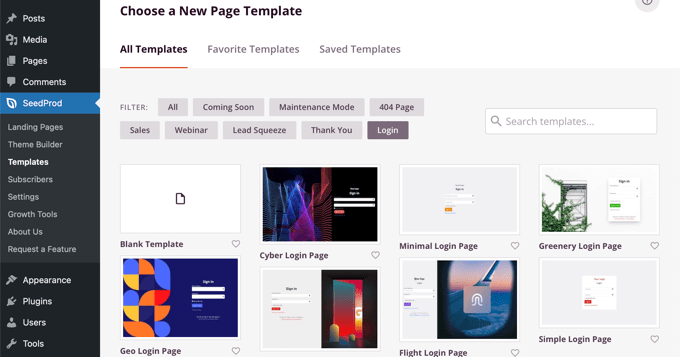
When you select a template, a popup window will appear to enter a Page Name for your login page. SeedProd will use the page name as the URL for your landing page.
Once you have entered these details, go ahead and click the ‘Save and Start Editing the Page’ button.
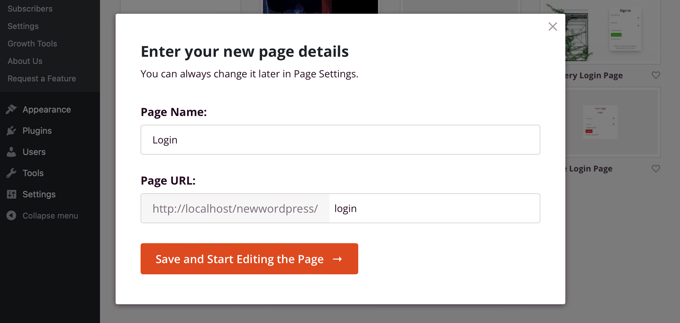
Now, you can edit your login page using SeedProd’s drag-and-drop builder in the Design tab. The builder lets you easily add any page block to the page by simply dragging it from the left menu and placing it anywhere on the page.
For example, you can add some text, a video, or a new button to your login page. There are more customization options in the Advanced Blocks section, where you can add a countdown timer, social sharing icons, and more.
SeedProd even lets you remove existing page blocks in the template. All you have to do is click the trash can icon to delete the page block.
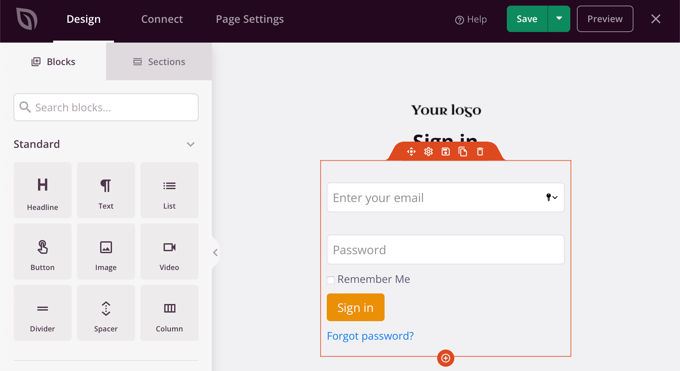
Next, if you click on any section on the login page, you’ll see more options for customization.
For instance, you can change the text and color of the fields, choose a different font, edit the button’s color, and more.
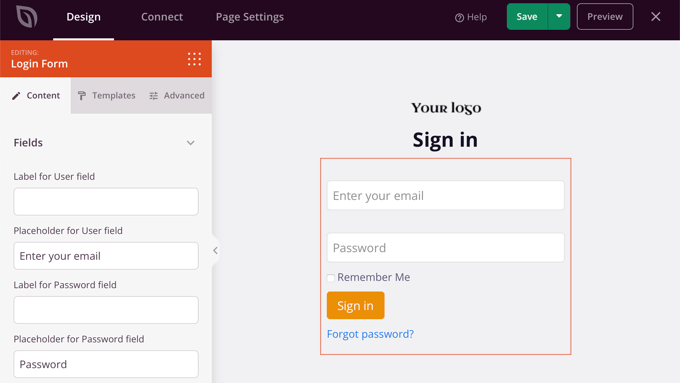
When you are satisfied with the design of the login page, click on the ‘Connect’ tab at the top.
You can now connect different email marketing services such as Constant Contact, Drip, and more.
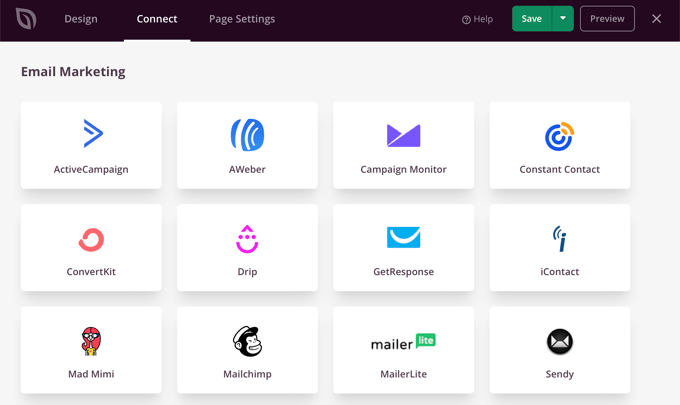
After that, you need to head over to the Page Settings tab. Under the General settings, SeedProd lets you edit the page title and change the page status from draft to publish.
You can also select the option to use a SeedProd Link and add your SeedProd affiliate link to make more money online.
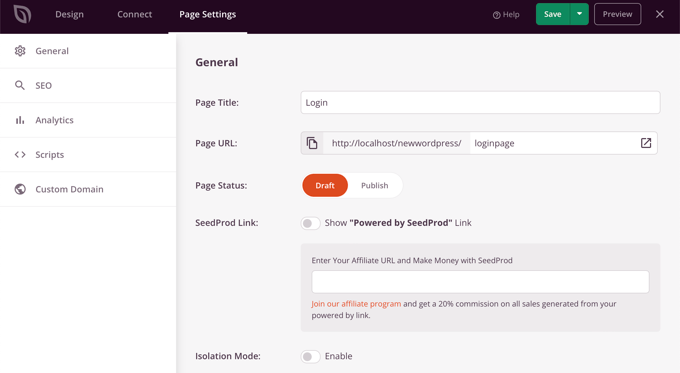
If you want to optimize your login page for search engines, then go to the SEO settings. Here, you’ll find a button that will install the All In One SEO plugin.
All in One SEO for WordPress (AIOSEO) is the best WordPress SEO plugin that allows you to optimize your WordPress website for search engines and social media platforms.
You can learn the best way to use it in our guide on how to set up All In One SEO for WordPress correctly.

After that, you can also add different code snippets to your login page in the Scripts settings tab.
For instance, you may want to add Google Analytics code, Facebook pixel, or other tracking code here.
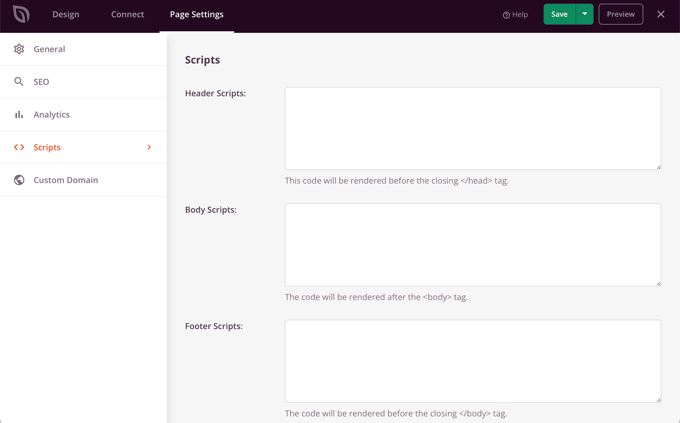
Now that you’ve changed the page settings, go ahead and click the ‘Save’ button at the top.
Next, you’ll have to make your login page active. To do that, you can exit the landing page builder and then go to SeedProd » Landing Pages.
Once there, you should click the switch to change the page status from ‘Inactive’ to ‘Active’.
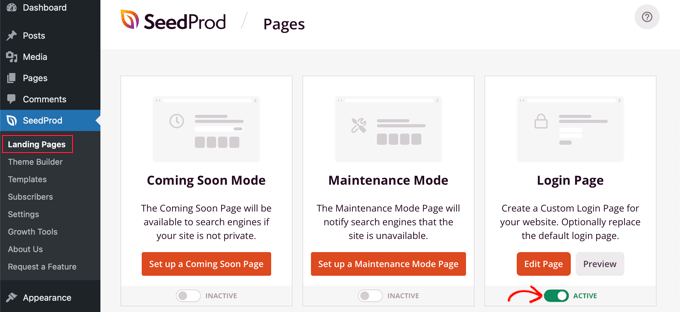
You can now go to the URL of your login page and see it in action.
This is a screenshot of the login screen on our demo site.
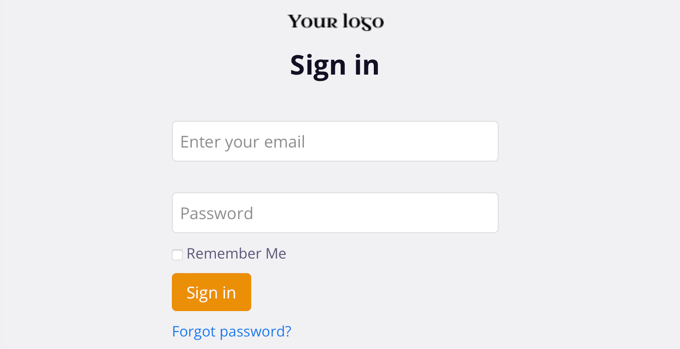
Alternative: You can also use Thrive Architect to design an attractive login page. It’s another great drag-and-drop page builder plugin that we recommend for creating custom pages.
It includes over 300+ professionally designed templates that allow you to make a login page that could look like the one below.
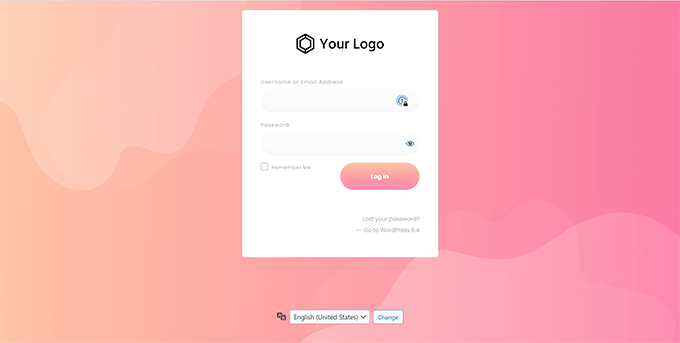
If WordPress page builder plugins are not your thing, then you can use custom CSS to style the form and the login page itself.
Change the WordPress Login Logo and URL
You don’t always need to create a custom WordPress login page for your website. A lot of websites replace the WordPress logo and logo URL while still using the default login page.
If you want to replace the WordPress logo on the login screen with your own logo, then you can easily use a WordPress plugin or add custom code. We will show you both methods, and you can use one that best suits you.
Method 1: Changing WordPress Login Logo and URL Using a Plugin
The first thing you need to do is install and activate the Colorlib Login Customizer plugin. For more details, see our step-by-step guide on how to install a WordPress plugin.
Upon activation, the plugin adds a new menu item to the WordPress theme customizer. Simply navigate to Appearance » Customize and click on the new ‘Colorlib Login Customizer’ item to launch the login customizer.
Note that this option is not available if you are using a block theme, so we recommend using the code method if that’s the case.
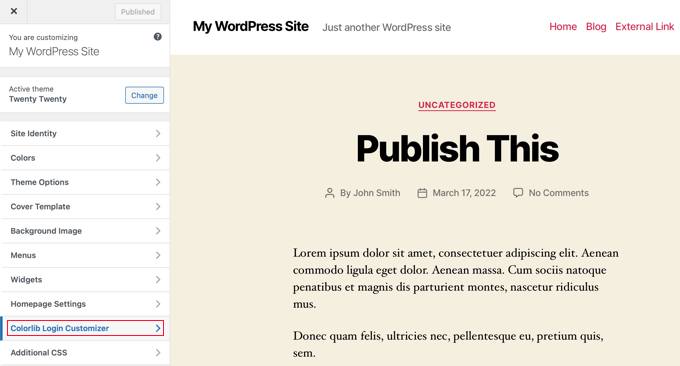
The login customizer will load your default WordPress login screen, which has customization options on the left and a live preview on the right.
To replace the WordPress logo with your own, click on the ‘Logo options’ tab on the right.
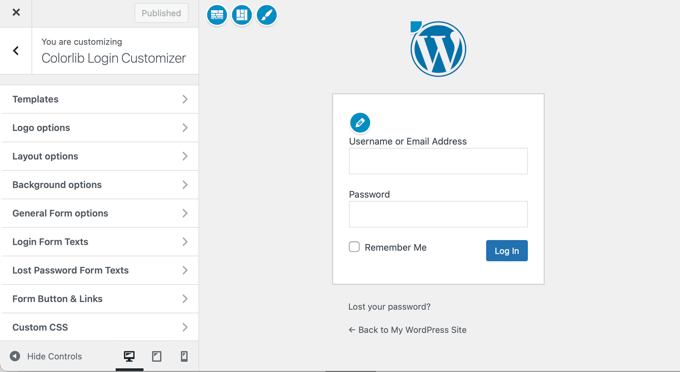
From here, you can hide the WordPress logo, upload your own custom logo, and change the logo URL and text.
You can also customize the size of the size and color of the text and the width and height of the custom logo.
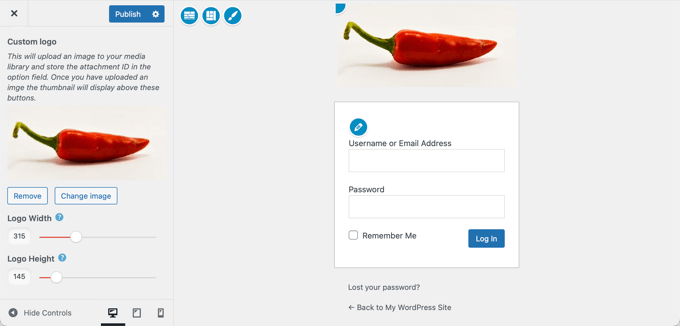
The plugin also allows you to customize the default WordPress login page completely. You can add columns and background images, change the login form colors, and more.
Basically, you can create a custom WordPress login page without changing the default WordPress login URL.
Once you are finished, simply click on the ‘Publish’ button to save your changes. You can now visit the WordPress login page to see your custom login form in action.
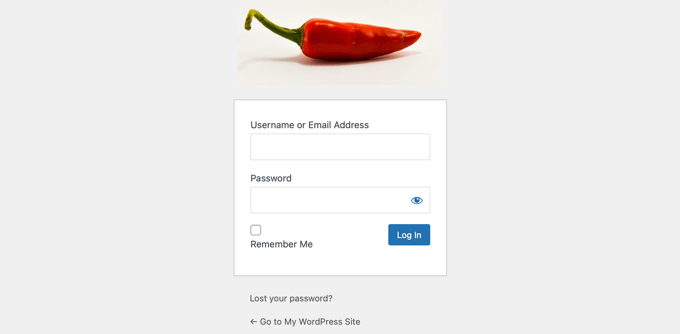
Method 2: Changing WordPress Login Logo and URL With Code
This method allows you to manually replace the WordPress logo on the login screen with your own custom logo without the need for a plugin. It is also suitable for block themes.
First, you need to upload your custom logo to the media library. Simply go to Media » Add New page and upload your custom logo.
Once you have uploaded the image, click on the ‘Edit’ link next to it. This will open the edit media page, where you need to copy the file URL and paste it somewhere convenient, such as a blank text file on your computer.
Next, you need to add the following code snippet to your theme’s functions.php file or use the WPCode plugin to easily add custom code without breaking your site (recommended):
function wpb_login_logo() { ?>
<style type="text/css">
#login h1 a, .login h1 a {
background-image: url(http://path/to/your/custom-logo.png);
height:100px;
width:300px;
background-size: 300px 100px;
background-repeat: no-repeat;
padding-bottom: 10px;
}
</style>
<?php }
add_action( 'login_enqueue_scripts', 'wpb_login_logo' );
Don’t forget to replace the background-image URL on Line 4 with the file URL you copied earlier. You can also adjust other CSS properties to match your custom logo image.
You can now visit the WordPress login page to see your custom logo.
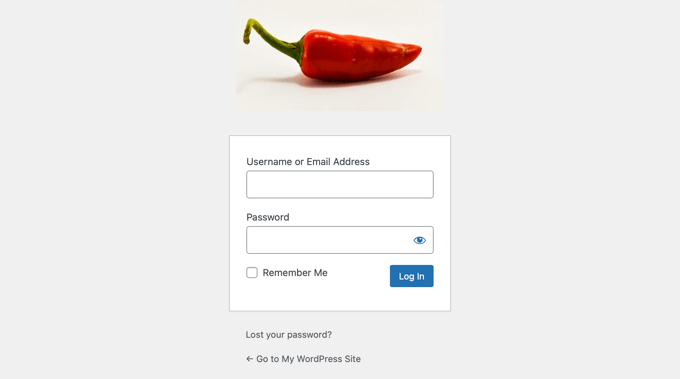
However, this code only replaces the WordPress logo. It does not change the logo link, which points to the WordPress.org website.
Let’s change this.
Simply add the following code to your theme’s functions.php file or WPCode. You can paste it right below the code you added earlier:
function wpb_login_logo_url() {
return home_url();
}
add_filter( 'login_headerurl', 'wpb_login_logo_url' );
function wpb_login_logo_url_title() {
return 'Your Site Name and Info';
}
add_filter( 'login_headertitle', 'wpb_login_logo_url_title' );
Don’t forget to replace ‘Your Site Name and Info’ with your site’s name. The custom logo on your login screen will now point to your site’s home page.
Disabling the WordPress Login Page Language Switcher
The release of WordPress 5.9 introduced a new dropdown login option that lets users select a new language when logging in to a website.
If there is more than one active language on the site, this option will appear.
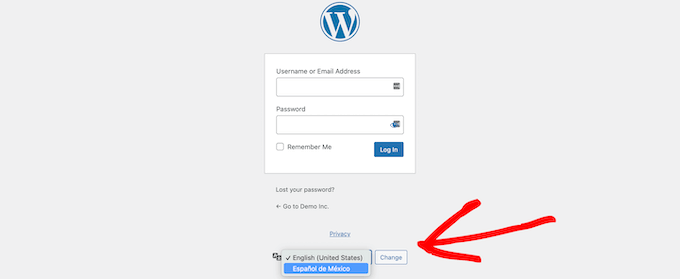
This works well for multilingual websites and teams with different users who might want to access the WordPress dashboard in a different language.
But if you want to keep your login page simple and your users don’t need to switch languages frequently, removing the language switcher can help declutter it. You can do this using a plugin or code.
Method 1: Disabling the Language Switcher With a Plugin
All you need to do is install and activate the Disable Login Language Switcher plugin. Upon activation, the language switcher option will automatically be removed. There are no additional settings for you to configure.
Now, when you go to your login screen, you’ll see the standard login screen without the language switcher option.

Method 2: Disabling the Language Switcher With Code
Another way you can disable the language switcher is by adding code to WordPress.
Simply add the following code snippet to your functions.php file or in WPCode snippets. For details, see our tutorial on how to add custom code snippets in WordPress:
add_filter( 'login_display_language_dropdown', '__return_false' );
For more details, see our guide on how to disable the language switcher on the WordPress login screen.
That’s all. We hope this article helped you learn different ways to create a WordPress login page for your website. You may also want to see our tutorial on adding a one-click Google login in WordPress or our guide on choosing the perfect color scheme for your website.
If you liked this article, then please subscribe to our YouTube Channel for WordPress video tutorials. You can also find us on Twitter and Facebook.





Dennis Muthomi
I manage multiple client sites and SeedProd has been a game-changer. It’s super easy to use but still gives you all the customization options you need.
I always add a custom message or helpful links under the login form. This works great for membership sites – your users can quickly find FAQs and support info.
Mrteesurez
As you have said in this article that many people used the default WordPress login page, but I want ask if it is safe ?, because that is the sample page admin also used to login.
Hope to there will not a hacking attempt ??
WPBeginner Support
For security concerns we would recommend taking a look at our guide below. There is no new security concerns added with a custom login page vs the standard login page.
https://www.wpbeginner.com/wordpress-security/
Admin
Jiří Vaněk
When it comes to attempts to hack into a website, I don’t see the default WordPress login page as a significant security risk. If someone wants to attack a website, it only takes a few seconds to determine whether the site uses WordPress or another technology. There are online tools where you can simply enter the domain name and within seconds find out if the site is using WordPress, and even which plugins it might be using (for example, services like builtwith.com). Changing the default login page is therefore more of a cosmetic change than a security measure.
Jiří Vaněk
This article will be a great use for websites I make for other people, so I can also make a login screen for them according to their wishes. Websites that are then managed by their owners can have a little something extra, which the competition usually does not, and that is always a big advantage. Moreover, I did not expect that it could be this simple.
Moinuddin Waheed
Thanks for this helpful guide as I have thought many times over to have different login page than the one comes default with WordPress.
I was not aware this is this much easy to get without having to do with complex set of code and thinking.
I will be using seedprod to get the beautiful login page for my websites.
KateOsborn
Thank you for your helpful videos. I have successfully installed TML and like the look of the login page. If not logged in, though, and an attempt is made to access different pages from the header, such as a product page, the user is taken to a default login page, not the TML one. How do I fix this? Thank you.
WPBeginner Support
That would depend on your specific site and if you have a membership plugin or a coming soon plugin that is redirecting your users that could be part of the issue.
Admin
Ashok Pandit
Confused about login url after we use the last method. What would be the login url if we use, “Change WordPress Login Logo and URL without Plugin (Code)”. I want to only to change login url though.
WPBeginner Support
The third method is for changing the logo URL not the login URL. The login URL would not change with that method.
Admin
Aidin Mohajer
Hi,
Thanks for all the information about wordpress. Very useful.
Best Regards
Aidin
WPBeginner Support
You’re welcome
Admin
kato d
Oh also, could you also show us how to use css to change the button color and text color on the login screen? I would like to make a fancy custom login page but at least changing away from the wordpress blue would look better with our black, white and red logo. thank you, helpful article, appreciate it!
WPBeginner Support
You would need to use CSS to edit the styling of your site like that, for a starting point you would want to take a look at our article below:
https://www.wpbeginner.com/wp-tutorials/basics-of-inspect-element-with-your-wordpress-site
Admin
kato d
Will check that out, thank you!
kato d
Thank you, very helpful, i used the code method to change the functions.php in my child theme to replace the wordpress logo with our own and it looks better now.
WPBeginner Support
Glad our guide could help you
Admin
Andanu
Its nice plugin
WPBeginner Support
Glad you like our recommendation
Admin